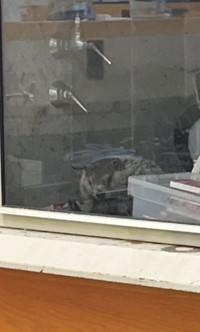Advertisement
Grab your lab coat. Let's get started
Welcome!
Welcome!
Create an account below to get 6 C&EN articles per month, receive newsletters and more - all free.
It seems this is your first time logging in online. Please enter the following information to continue.
As an ACS member you automatically get access to this site. All we need is few more details to create your reading experience.
Not you? Sign in with a different account.
Not you? Sign in with a different account.
ERROR 1
ERROR 1
ERROR 2
ERROR 2
ERROR 2
ERROR 2
ERROR 2
Password and Confirm password must match.
If you have an ACS member number, please enter it here so we can link this account to your membership. (optional)
ERROR 2
ACS values your privacy. By submitting your information, you are gaining access to C&EN and subscribing to our weekly newsletter. We use the information you provide to make your reading experience better, and we will never sell your data to third party members.
Analytical Chemistry
Newscripts
Sniffing Out Old Age, Chasing Crows
by Lauren K. Wolf
June 25, 2012
| A version of this story appeared in
Volume 90, Issue 26

A number of things are said to get better with age: wine, scotch, and certain cheeses, to name a few. But according to a report in PLoS ONE, this list should now include raw body odor (DOI: 10.1371/journal.pone.0038110).
A group of researchers led by Johan N. Lundström of the Monell Chemical Senses Center, in Philadelphia, has determined that humans are generally able to identify other humans’ age by smell and that body odors emitted by elderly people are more pleasant and less intense than the odors of their younger cohort.
Inspired by previous studies suggesting that animals can identify age via body odor, Lundström’s team set out to learn whether humans’ noses are sensitive enough to do the same. So the researchers sampled the body odors of people in three age groups—young (20–30 years old), middle-aged (45–55), and old (75–95)—by having volunteers wear the same T-shirt to bed for five consecutive nights. Before donning the shirt and nodding off, the volunteers had to wash themselves with unscented soaps to make sure hygiene products didn’t interfere with test results.
A group of about 40 participants then smelled underarm pads collected from the volunteers’ T-shirts and ranked them for odor intensity and pleasantness. When asked to blindly categorize the samples with “young,” “middle-aged,” or “old” labels, the participants correctly identified the samples from the elderly participants more often than the others.
As people age, Lundström’s team writes, their body odors likely change because of alterations to skin gland secretions and microbial inhabitants. The researchers say they will next try to isolate the exact compounds, or biomarkers, responsible for the more pleasant “old person odor.”
It’s not every day that the Newscripts gang receives an actual hand-typed letter in the mail—particularly one from Japan. So we sat up and took notice recently when reader Kohtaro Matsuo of Osaka sent in a note.

Matsuo, a member of the American Chemical Society for 47 years, translated an article from his local newspaper about a talented high school student who is trying to save Japan’s Saga City from some pesky inhabitants. Misato Ishibashi, a 17-year-old falconry whiz, is doing battle with hordes of crows that have taken up residence in the city’s center. Desperate for help, government officials called Ishibashi in when they heard of her skill with birds of prey.
To fight the noisy garbage-pickers, the teenager looses her pet Harris hawk, named Momotaro, on the flock, an act that she says, “scares the hell out of the crows” and causes them to disperse, according to a May 15 article in the Japan Times.
In the wild, hawks don’t typically chase crows, says Patrick T. Redig, a falconer with 50 years of experience who is now director of the Raptor Center at the University of Minnesota. But the predatory birds certainly can be trained to do so, he adds. “It’s basically a hazing operation.”
Here in the U.S., Redig tells Newscripts, quite a few falconers have contracts with airports “to keep birds in the vicinity moving and to keep them uncomfortable.” That way, the birds don’t interfere with plane takeoffs and landings.
When asked whether Ishibashi might succeed in rescuing Saga City from the dreaded crows, Redig is skeptical. “She’s very expert at what she’s doing,” as evidenced by videos online, he says. But flocks of crows aren’t easily shooed away permanently, especially when there’s a source of food, such as trash piles, lying around. “If she was in there every day,” Redig adds, “she could keep them moving, though.”
Time will tell whether Ishibashi becomes Saga City’s champion or whether her efforts are merely a flight of fancy.
Lauren K. Wolf wrote this week’s column. Please send comments and suggestions to newscripts@acs.org.





Join the conversation
Contact the reporter
Submit a Letter to the Editor for publication
Engage with us on Twitter